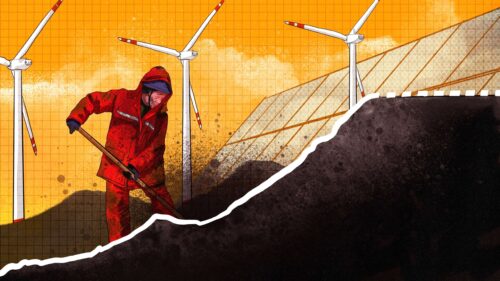Far out: Offshore floating wind power is taking off in China
China is leading the world in terms of offshore wind power capacity, and as Hainan starts construction of the world’s largest offshore floating wind power project, China is now making a big play for harnessing greater wind power with floating wind turbines located further out to sea and in deeper waters.

Yesterday, a groundbreaking ceremony took place for China’s first (and the world’s largest) deep-sea offshore wind power project, which is being constructed by PowerChina 中国电建 and is located 22 kilometers (13 miles) off the coast of Wanning County, southeastern Hainan Island:
- The project will have a total capacity of 1 million kilowatts (kW) and average annual power generation of about 4.2 billion kilowatt hours (kWh).
- The average water depth at the project is 100 meters (328 feet), and the total planned area is 160 square kilometers (61 square miles).
- The first phase of the project, which includes 12 floating wind turbines, will be completed and connected to the grid by the end of 2025.
Far out and deep: The next frontier of offshore wind power
According to the International Energy Agency (IEA), in 2021, China constructed three times as much offshore wind farm capacity as the rest of the world put together: Of the global total of 10.5 gigawatts (GW) of new capacity added in 2021, China accounted for 8 GW. China has now overtaken the U.K. as the world’s leading country in terms of offshore wind power capacity, with China standing at 17 GW, a figure that more than doubled in 2021, and the U.K. standing at 11 GW.
Conventional offshore wind turbines rest on the seabed and cannot be installed in water deeper than about 40 meters (131 feet), which in most regions means they have to be constructed within 30 kilometers (18 miles) of the shoreline. Floating wind turbines, however, are the next frontier of offshore wind power, and can be constructed further out to sea with the ability to harness greater wind power. The world’s first floating wind farm, the 30-megawatt (MW) Hywind pilot project located 29 kilometers (18 miles) off the coast of Scotland, has been in operation since 2017.
China currently has plans to install floating wind power capacity of 477 MW by 2026, which would be a fivefold increase from 2021. So far, China only has one operational floating wind power project, a “typhoon-proof” trial project that was installed in July 2021 by China Three Gorges Corporation (CTGC) 三峡集团 at the Yangjiang offshore wind farm, located 72 kilometers (44 miles) off the coast of Guangdong Province. The U.K. consultancy Westwood Energy has counted eight further offshore floating wind power projects that are set to be commissioned in China by 2026.
The Yangjiang project has a water depth of 30 meters (98 feet), and the new project off Hainan will have a depth of 100 meters (328 feet), but most of the other projects planned up to 2026 will have a water depth of less than 70 meters (229 feet). At present, floating wind power projects can be installed at depths of up to 300 meters (984 feet). The world’s largest floating wind farm, Hywind Tampen, for example, located 140 kilometers (87 miles) off the Norwegian coast, has a depth of up to 300 meters (984 feet).
In June 2022, China’s first domestically produced floating wind turbine, the Fúyáo 扶摇号, was installed at a demonstration project off the coast of Guangdong Province by China State Shipbuilding Corporation (CSSC) 中国海装. The floating platform has a total length of 72 meters (236 feet) with a wind turbine of 6.2 MW capacity, and has an average operational depth of 65 meters (213 feet).
—Barry van Wyk






